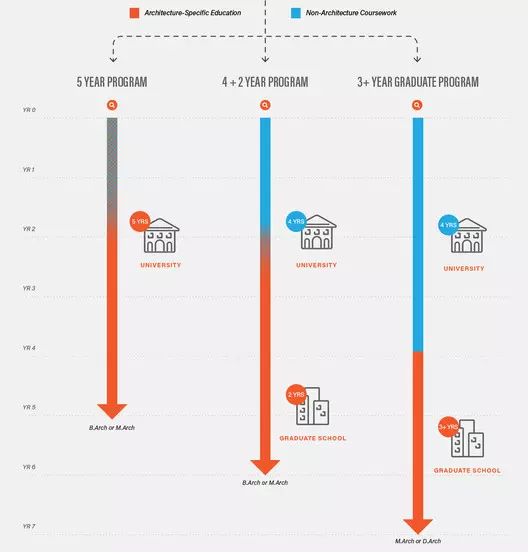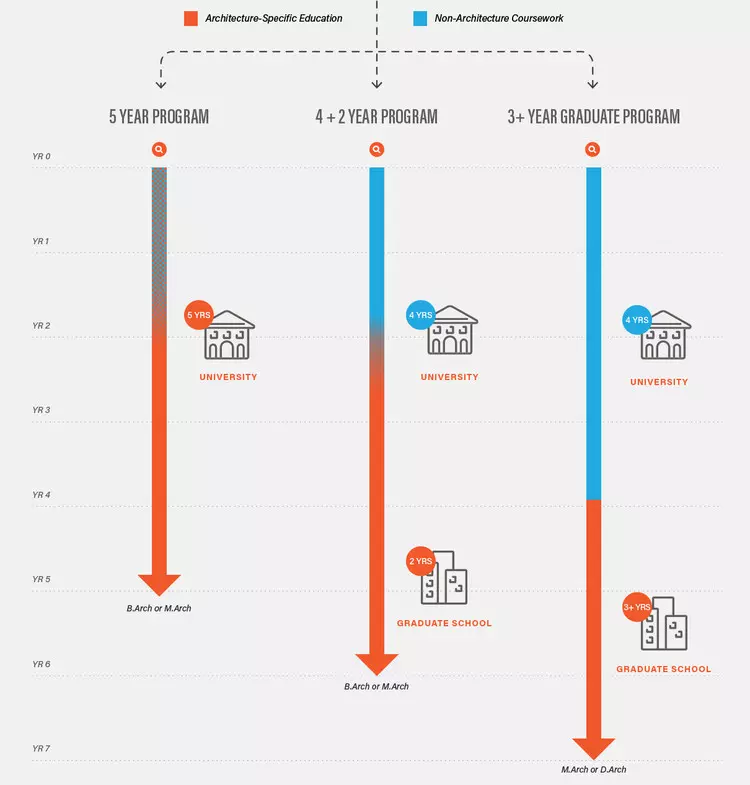 Image: Milstein Hall, at Cornell University's College of Architecture, designed by OMA. Image © Matthew Carbone
Image: Milstein Hall, at Cornell University's College of Architecture, designed by OMA. Image © Matthew Carbone
The journey to becoming an architect can be both confusing and extensive. In this article, we will demystify a crucial component of the path to a career in architecture: the degree you should pursue. Specifically, we will explore the key differences between two common and somewhat comparable degrees: the B.Arch and the M.Arch.
Understanding the B.Arch Degree
Let's start with the B.Arch. In most countries, the Bachelor of Architecture is a five-year, pre-professional undergraduate program designed for students who are certain about their career in architecture, even before graduating high school. During the initial one to two years, students often take non-architecture courses alongside classes that help develop their drafting and rendering skills. The remaining three years are focused on architecture techniques and building codes.
All B.Arch programs are accredited by the National Architecture Accrediting Board (NAAB) in the United States, the RIBA in the UK, and other local accreditation boards in various countries. Before enrolling in a degree course, it is important to verify the relevant accreditation body in your country and ensure that the desired course is accredited. In some countries, completing an accredited B.Arch degree allows students to take the Architect Registration Examination (ARE) or an equivalent registration exam. In other countries, such as the UK, the B.Arch serves as the initial step towards obtaining licensure. Although the specifics of a B.Arch program and the path to becoming an architect vary across countries, the underlying concept remains consistent: a professional degree that fast-tracks you into the architecture profession.
 Image: The 3 main types of degree track available in the USA. Image courtesy of StudyArchitecture.com
Image: The 3 main types of degree track available in the USA. Image courtesy of StudyArchitecture.com
The M.Arch Degree: Taking Architectural Education Further
The M.Arch is a post-graduate program that prepares students to become registered architects. To enroll in an M.Arch program, students must hold an undergraduate degree. Typically, the Masters of Architecture degree is offered to individuals who have completed an undergraduate liberal arts education. Some M.Arch students may have studied unrelated subjects like English during their undergraduate years. Others may have already obtained a B.S., B.A., or B.Arch in architecture and choose to attend graduate school to deepen their theoretical understanding of architectural practice.
Due to the varied backgrounds of M.Arch students, many universities offer multiple tracks within the program, often distinguished as "M.Arch I" and "M.Arch II." For students with non-architecture undergraduate degrees, the M.Arch typically takes three to three and a half years to complete. Graduate schools often provide a two-year M.Arch program, known as "4+2", for students who already hold an undergraduate degree in architecture. This program complements their existing architectural education and further refines their skills and knowledge.
 Image: Rudolph Hall at the Yale Art + Architecture Building. Image Courtesy of Gwathmey Siegel and Associates Architects
Image: Rudolph Hall at the Yale Art + Architecture Building. Image Courtesy of Gwathmey Siegel and Associates Architects
Make the Right Choice for Your Architectural Journey
When considering which degree to pursue, it is essential to explore the options available to you. Consult Quacquarelli Symonds's list of the top 200 architecture schools in the world to find institutions that offer the degree that aligns with your aspirations and goals.
 Image: McEwen School of Architecture, designed by LGA Architectural Partners. Image Courtesy of LGA Architectural Partners
Image: McEwen School of Architecture, designed by LGA Architectural Partners. Image Courtesy of LGA Architectural Partners
In conclusion, understanding the differences between a B.Arch and M.Arch degree is crucial for aspiring architects. The B.Arch offers an accelerated path into the architecture profession, while the M.Arch provides an opportunity to refine skills and broaden theoretical knowledge. Consider your educational background and long-term career goals when making this important decision.












